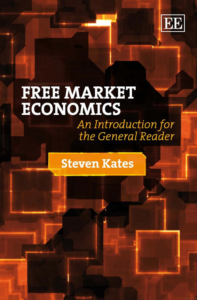Free Market Economics: An Introduction for the General Reader, by Steven Kates. Northampton, MA: Edward Elgar Publishing, 2011. 352 pp. $50 (paperback).
 Not since 1924 has there been a comprehensive yet readable book on economics aimed at the ordinary but intelligent citizen that defends and incorporates the field’s foundational principle, Say’s Law (named after Jean-Baptiste Say, 1767–1832) and its main corollaries: the primacy of production, the entrepreneur as prime mover, and prices as the commercial language that coordinates economies and their subsectors. Now we have such a book: Free Market Economics: An Introduction for the General Reader by Australian business economist Steven Kates. His prior books examined the prevalence of Say’s Law among top economists during the pro-capitalist 19th century and its abandonment by most economists in the anti-capitalist 20th century.
Not since 1924 has there been a comprehensive yet readable book on economics aimed at the ordinary but intelligent citizen that defends and incorporates the field’s foundational principle, Say’s Law (named after Jean-Baptiste Say, 1767–1832) and its main corollaries: the primacy of production, the entrepreneur as prime mover, and prices as the commercial language that coordinates economies and their subsectors. Now we have such a book: Free Market Economics: An Introduction for the General Reader by Australian business economist Steven Kates. His prior books examined the prevalence of Say’s Law among top economists during the pro-capitalist 19th century and its abandonment by most economists in the anti-capitalist 20th century.
The handful of texts on economic principles since the 1920s that recognize the superiority of a free economy have been too technical, narrowly devoted to refuting economic fallacies, or tainted by dubious philosophy. This book avoids such flaws. Kates accomplishes what was last achieved by Oxford professor Henry Clay (1883–1945) in Economics: An Introduction for the General Reader (1924). Better still, Kates’s book offers a modern, more sophisticated, more pro-capitalist treatment than did Clay’s book, and it provides the ideas people need to grasp and refute the disastrous dogmas and policies of Keynesianism.
At the core of this book is Say’s Law, the principle that supply constitutes demand, that one cannot demand (or purchase) anything in any market without first producing an economic value for offer (or, in a monetary economy, without first earning spendable income by producing value). This principle recognizes that markets are made by the producers and that the most economically important producer of all is the entrepreneur, who specializes in soliciting and coordinating the other main factors of production: land (including raw materials), labor, capital, and financing. Say’s Law condenses the truth that material prosperity is attained not by consuming (using up) wealth, but by saving, investing, and producing wealth. Unlike most textbooks today, Kates’s says economics should explain wealth creation, or “net added value,” not how we ration “scarce resources.”
Keynesianism, Kates explains, explicitly rejects Say’s Law and asserts that a free market is prone to “failures” and crises, to excessive production, deficient consumption, and depressions; it further insists that government deficit spending, money printing, and near-zero interest rates can fix said market failures. . . .














